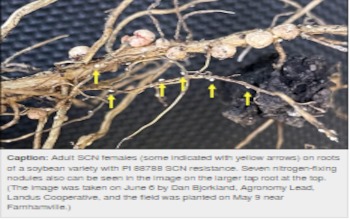Adult females of SCN can be seen on roots of infected soybean plants with the unaided eye. So, digging roots and looking for the telltale white females is an effective way to check for SCN in the field.
It takes from 4 to 6 weeks after planting for SCN females initially to appear on the root surface. The first SCN females of 2023 now are visible, and additional adult females will appear on infected roots for the remainder of the growing season.
Roots need to be dug from the soil with a shovel or spade at least 8 inches deep, not pulled, to recover the smaller, younger roots on which SCN females are found.
The SCN females (see image below) are small, white, lemon-shaped objects, about the size of a period at the end of a printed sentence. They are much smaller and lighter in color than the nitrogen-fixing nodules (also shown below) present on healthy soybean roots.

Information on Managing SCN
There are several sources of information available online about scouting for and managing SCN. See:
Category:
Plant Diseases
Links to this article are strongly encouraged, and this article may be republished without further permission if published as written and if credit is given to the author, Integrated Crop Management News, and Iowa State University Extension and Outreach. If this article is to be used in any other manner, permission from the author is required. This article was originally published on June 12, 2023. The information contained within may not be the most current and accurate depending on when it is accessed.
Source : iastate.edu